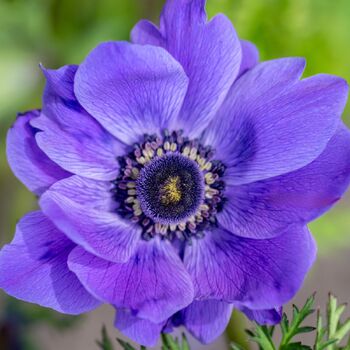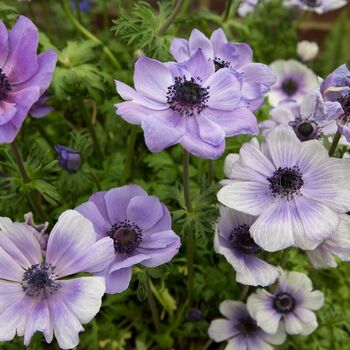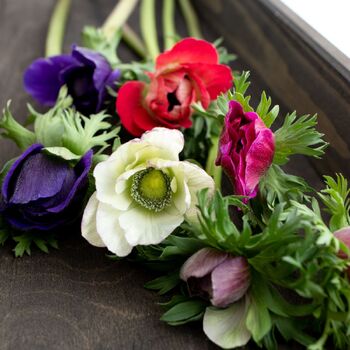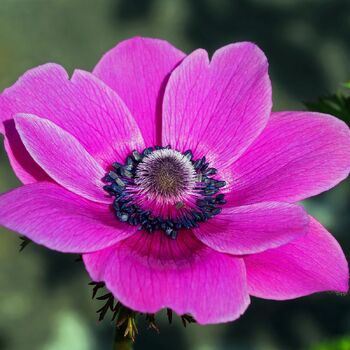
How to Grow Anemone Corms
Grow Guide #2603
Family: Ranunculaceae
Binomial name: Anemone coronaria
Life Cycle: Perennial
This 'How to Grow' guide details everything a home gardener needs to know to plant, grow and care for Anemones (Anemone coronaria).
When to Plant Anemone Corms
Use the table below to identify the best time of year to plant anemone corms in your climate.
| JAN | FEB | MAR | APR | MAY | JUN | JUL | AUG | SEP | OCT | NOV | DEC | |
|---|---|---|---|---|---|---|---|---|---|---|---|---|
| Cool | ||||||||||||
| Temperate | ||||||||||||
| Sub-Tropical | ||||||||||||
| Tropical | ||||||||||||
| Arid |
Preparation
Anemone plants are best grown in full sun. Choose a location that will receive at least 6 hours of full sun each day.
Anemone plants need a loose, well drained soil enriched with organic matter. Prepare soil by weeding it thoroughly, digging it over to at least a spade’s depth to loosen the soil, and adding aged animal manure or compost. Organic matter can be dug into heavy soil to lighten it so roots can grow freely. Keep the area free of weeds until planting. Learn more about preparing soil for planting here.
Anemone plants can be grown in containers. If possible choose a variety that’s recommended for container growing. Use a good quality potting mix and make sure your container is large enough for mature plants; a minimum of 10 litres is recommended for anemones. During the growing season, keep in mind that container grown plants may need additional fertiliser to encourage healthy growth.
How to Plant Anemone Corms
Optional: Soak corms in room temperature water for 1-3 hours before planting. The corms should absorb water and swell up. Do not leave corms soaking for longer than recommended as this puts them at risk of rotting.
Anemone corms should be planted directly in their final position in the garden or a container.
- Plant individual corms 10cm apart and 4cm deep with the point facing down. In subtropical climates plant the corms 8cm deep to protect them from warm temperatures near the surface of the soil.
- Cover with soil and water in well.
- Keep soil moist but not wet until shoots emerge.
How to Grow Anemone
Anemone plants may need watering during the growing season. Water when the soil is dry about 5cm below the surface (test this by scratching away a little soil with your finger). Water deeply in the early morning or late afternoon. Avoid watering the leaves of plants to avoid fungal diseases. Learn more about watering here.
If soil was well prepared no extra fertiliser should be necessary. In poor soil or to give your plants an extra boost, application of a high-potassium fertiliser or one formulated for flowering plants can be beneficial:
- Apply slow release fertiliser at the recommended rate when transplanting or when seedlings are 5-10cm tall.
- Apply liquid fertiliser at the recommended rate and frequency while plants are fruiting or flowering.
Anemone plants should flower in approximately 90-110 days.
Deadhead anemone flowers regularly during the growing season. Using sharp secateurs or snips cut fading or dead flowers off just above a set of leaves. Removing old flowers regularly will encourage plants to produce more flowers. Learn more about deadheading flowering plants here.
If growing anemones for cut flowers, use sharp snips or secateurs to cut the longest stems possible, removing the lower leaves and placing the stems immediately in a clean bucket of water. Learn more about cutting and conditioning homegrown flowers here.
Anemones can be grown as annuals and discarded after flowering, left to naturalise and rebloom next season, or lifted, stored and replanted in autumn. If left to naturalise anemones are short-lived perennials and will need to be replaced after 2-3 years.
To lift corms wait until the foliage turns yellow. Cut the foliage off at ground level, then use a garden fork to lift corms from the soil, taking care not to damage them. Spread the corms on a wire rack in a cool, dry place for 10-14 days to dry them. Then store the corms in a net bag until it is time to replant them in autumn.
Common Problems when Growing Anemones
Like all plants, anemone is susceptible to some pests, diseases and other problems. Below is a list of the most common problems gardeners encounter when growing anemone plants:
 Aphids are small (2-4mm long) sap-sucking insects that congregate on the new shoots or the undersides of leaves. They can cause leaves to wilt or become discoloured, and also excrete honeydew which can attract ants and other insect pests. To manage aphids, remove them by spraying with a garden hose, apply a soap or alcohol spray, or encourage predatory insects to your garden. Read more about aphids here.
Aphids are small (2-4mm long) sap-sucking insects that congregate on the new shoots or the undersides of leaves. They can cause leaves to wilt or become discoloured, and also excrete honeydew which can attract ants and other insect pests. To manage aphids, remove them by spraying with a garden hose, apply a soap or alcohol spray, or encourage predatory insects to your garden. Read more about aphids here.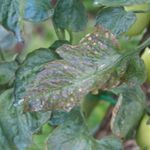 Downy mildew is a fungal disease that causes yellow to grey-brown patches on leaves, especially the undersides. Water plants at soil level (not on the leaves), remove and destroy affected leaves and do not overcrowd plants to ensure adequate air flow. If problems persist, spray with a homemade milk spray or fungicide.
Downy mildew is a fungal disease that causes yellow to grey-brown patches on leaves, especially the undersides. Water plants at soil level (not on the leaves), remove and destroy affected leaves and do not overcrowd plants to ensure adequate air flow. If problems persist, spray with a homemade milk spray or fungicide..jpg) Powdery mildew is caused by fungal spores reproducing on the leaves of plants. First showing as white spots on leaves, affected areas can spread quickly to cover the entire leaf surface. While rarely fatal, powdery mildew can reduce yields. Water plants at soil level (not on leaves) to prevent spreading spores, allow good air flow between plants, remove affected leaves and if necessary spray with an appropriate fungicide or homemade spray. Read more here about powdery mildew here.
Powdery mildew is caused by fungal spores reproducing on the leaves of plants. First showing as white spots on leaves, affected areas can spread quickly to cover the entire leaf surface. While rarely fatal, powdery mildew can reduce yields. Water plants at soil level (not on leaves) to prevent spreading spores, allow good air flow between plants, remove affected leaves and if necessary spray with an appropriate fungicide or homemade spray. Read more here about powdery mildew here.%20(3).jpg) Rotten corms are caused by pathogens entering corms after sitting in cold, wet soil or being temporarily waterlogged. Corms may show obvious signs of rot or have no roots or shoots. If soaking corms before planting, do not soak them for longer than recommended. Plant corms in free-draining soil, raised garden beds or containers. If growing corms as perennials, lift and store them over winter and replant in spring.
Rotten corms are caused by pathogens entering corms after sitting in cold, wet soil or being temporarily waterlogged. Corms may show obvious signs of rot or have no roots or shoots. If soaking corms before planting, do not soak them for longer than recommended. Plant corms in free-draining soil, raised garden beds or containers. If growing corms as perennials, lift and store them over winter and replant in spring. Slugs and snails are molluscs that feed on tender leaves and shoots, mostly at night, leaving slimy trails behind them. Control them by removing their hiding places, keeping free range poultry, collecting them by torchlight or by placing traps. Read more about slugs and snails here.
Slugs and snails are molluscs that feed on tender leaves and shoots, mostly at night, leaving slimy trails behind them. Control them by removing their hiding places, keeping free range poultry, collecting them by torchlight or by placing traps. Read more about slugs and snails here.


.png)



